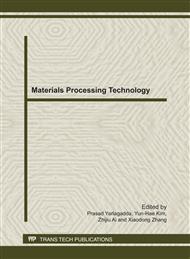[1]
K.Weinert, A consideration of tool wear mechanism when machining metal matrix composite (MMC), Ann. CIRP 42 (1993) 95-98.
DOI: 10.1016/s0007-8506(07)62400-7
Google Scholar
[2]
J.T. Lin, D. Bhattacharyya, C. Lane,Machinability of a silicon carbide reinforced aluminium metal matrix composite, Wear 181-183 (1995) 883-888.
DOI: 10.1016/0043-1648(95)90211-2
Google Scholar
[3]
C.A.C. Antonio, J.P. Davim, Optimum cutting conditions in turning of particulate metal matrix composites based on experimental and a generic search model, Composites Part A 33 (2002) 213-219.
DOI: 10.1016/s1359-835x(01)00094-x
Google Scholar
[4]
M. El-Gallab,M. Sklad, Machining of Al/SiC particulate metal matrix composites Part I: tool performance, J. Mater. Process. Technol. 83 (1998) 151-158.
DOI: 10.1016/s0924-0136(98)00054-5
Google Scholar
[5]
C.J.E. Andrews, H.Y. Feng, W.M. Lau, Machining of an aluminium/SiC composite using diamond inserts, J. Mater. Process. Technol. 102 (2000) 25-29.
Google Scholar
[6]
Paulo Davim J. Diamond tool performance in machining metal-matrix composites. J Mater Process Technol. 2002;128:100-5.
Google Scholar
[7]
Peter J. Heath, Developments in applications of PCD tooling, Journal of Materials Processing Technology 116 (2001) 31-38
DOI: 10.1016/s0924-0136(01)00837-8
Google Scholar
[8]
X. Ding, W.Y.H. Liew, X.D. Liu, Evaluation of machining performance of MMC with PCBN and PCD tools, Wear 259 (2005) 1225-1234
DOI: 10.1016/j.wear.2005.02.094
Google Scholar
[9]
J.A. Arsecularatne, L.C. Zhang, C. Montross, Wear and tool life of tungsten carbide, PCBN and PCD cutting tools, International Journal of Machine Tools & Manufacture 46 (2006) 482–491
DOI: 10.1016/j.ijmachtools.2005.07.015
Google Scholar
[10]
Q.S. Bai, Y.X. Yao , Phillip Bex , G. Zhang ,Study on wear mechanisms and grain effects of PCD tool in machining laminated flooring, International Journal of Refractory Metals & Hard Materials 22 (2004) 111-115
DOI: 10.1016/j.ijrmhm.2004.01.007
Google Scholar
[11]
J.A. Arsecularatne, Prediction of tool life for restricted contact and grooved tools based on equivalent feed, International Journal of Machine Tools & Manufacture 44 (2004) 1271-1282
DOI: 10.1016/j.ijmachtools.2004.04.022
Google Scholar
[12]
Y. Kevin Chou, Chris J. Evans, Moshe M. Barash, Experimental investigation on CBN turning of hardened AISI 52100 steel, Journal of Materials Processing Technology 124 (2002) 274-283
DOI: 10.1016/s0924-0136(02)00180-2
Google Scholar
[13]
J.A. Arsecularatne, L.C. Zhang, C. Montross, Wear and tool life of tungsten carbide, PCBN and PCD cutting tools, International Journal of Machine Tools & Manufacture 46 (2006) 482-491 Fig. 1 Fig. 1 Photographs of a fresh PCD tool: (a) flank face and (b) rake face. Fig. 2 Fig. 2 Photographs of a tool flank face (c–e) and rake face (f–h) at different cutting time (PCD 010, in wet cutting, cutting speed: 150 m/min, feed rate: 0.1 mm/rev, and depth of cut: 0.15 mm). Fig. 3 Fig. 3 Effect of cutting speed on tool life of PCD 010 and PCD 030 on a log–log basis (in wet cutting, cutting speed: 120-200 m/min, feed rate: 0.1 mm/rev, and depth of cut: 0.15 mm) Fig. 4 Fig. 4 Taylor lines for PCD 010 and PCD 030 on granite (cutting speed: 120-200 m/min, feed rate: 0.1 mm/rev, and depth of cut: 0.15 mm) Fig. 5 Fig. 5 SEM of fresh PCD tools: (a) PCD 010, (b) PCD 030. Fig. 6 Fig. 6 SEM of the PCD 010 used to machine granite bar at 120 m/min for a maximum flank wear of 0.5 mm. Fig. 7 Fig. 7 SEM of the PCD 010 used to machine granite bar at 200 m/min for a maximum flank wear of 0.5 mm. Fig. 8 Fig. 8 SEM of the PCD 030 used to machine granite bar at 120 m/min for a maximum flank wear of 0.5 mm. Fig. 9 Fig. 9 SEM of the PCD 030 used to machine granite bar at 200 m/min for a maximum flank wear of 0.5 mm. Table 1 Chemical composition of granite SiO2
Al2O3
K2O
Na2O
CaO
FeO
Fe2O3
MgO
TiO2
P2O5
MnO
72.04%
14.42%
4.12%
3.69%
1.82%
1.68%
1.22%
0.71%
0.30%
0.12%
0.05%
Table 2 Tool geometry Rake angle(°)
Relief angle(°)
Chamfer angle(°)
Chamfer length(mm)
Approach angle (°)
-5
5
20
0.2
95
Table 3 Process parameters in different machining sets Cutting test
Cutting speed (m/min)
Feed rate (mm/rev)
Depth of cut (mm)
120 ,150 , 180 , 200
0.1
0.15
Google Scholar


